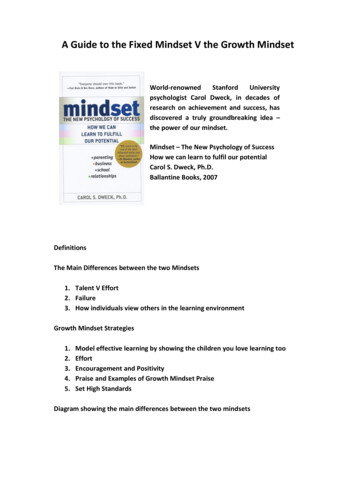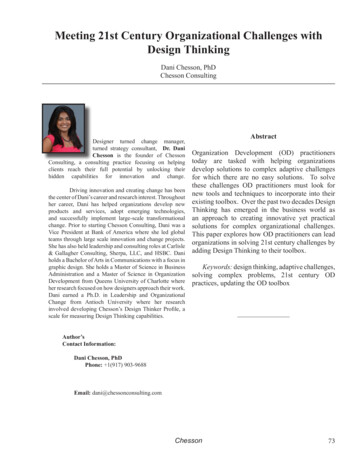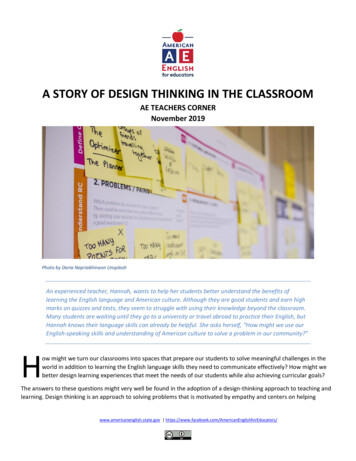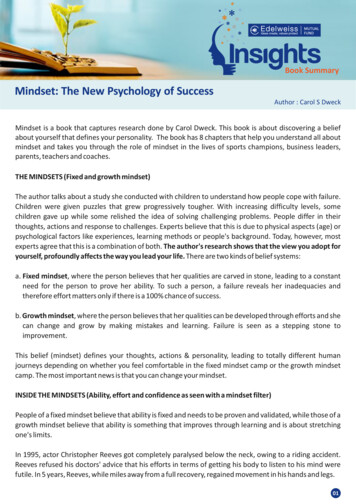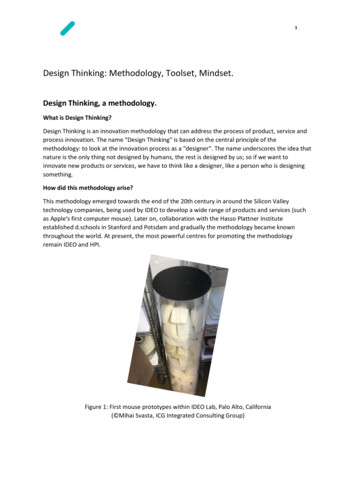
Transcription
1Design Thinking: Methodology, Toolset, Mindset.Design Thinking, a methodology.What is Design Thinking?Design Thinking is an innovation methodology that can address the process of product, service andprocess innovation. The name "Design Thinking" is based on the central principle of themethodology: to look at the innovation process as a "designer". The name underscores the idea thatnature is the only thing not designed by humans, the rest is designed by us; so if we want toinnovate new products or services, we have to think like a designer, like a person who is designingsomething.How did this methodology arise?This methodology emerged towards the end of the 20th century in around the Silicon Valleytechnology companies, being used by IDEO to develop a wide range of products and services (suchas Apple's first computer mouse). Later on, collaboration with the Hasso Plattner Instituteestablished d.schools in Stanford and Potsdam and gradually the methodology became knownthroughout the world. At present, the most powerful centres for promoting the methodologyremain IDEO and HPI.Figure 1: First mouse prototypes within IDEO Lab, Palo Alto, California( Mihai Svasta, ICG Integrated Consulting Group)
2Tim Brown (IDEO) defines Design Thinking as follows”Design thinking is a human centered and collaborative approach to solve complex problems”.This definition speaks of 3 features of this methodology:-Put the human / user / client at the centre of this methodologyCollaborative work in a teamTo address complex or ambiguous problemsWhat makes appropriate this methodology?This methodology is appropriate whenever we have a product, service, or process that has as a finalbeneficiary a human being, or humanity as a whole. The main feature of the Design Thinkingmethodology is that it is a "Human Centered Process". Compared with other innovationmethodologies (TRIZ, DEFT, H4X), Design Thinking focuses on the end-user, trying to design theproduct, the final service according to its wishes. This is one of the fundamental principles of DesignThinking:”Truth” stays with the consumer, with the user, with the client. And we must build on this”Truth”.When is this methodology inappropriate?Lately, with the spread of the concept of Design Thinking, the emergence of various organizationsand societies that promote this methodology, there is a risk that either this methodology can bemodified and adapted by losing its essence and content, whether this methodology becomes apanacea universal, being applied to any problems. It is good to be aware that this methodologybecomes powerless for non-human-centered innovation processes or where "radical innovation" isdesirable, that is, a direction of innovation that cannot even be imagined by the user. In somesituations, the right approach is to use certain elements of Design Thinking and to combine themwith elements from other innovation methodologies.What are the Design Thinking stages?In the sense of the Hasso Plattner Institute, also used by the ICG Integrated Consulting Group, thismethodology has 6 stages:Understand: The innovation team defines the theme of the innovation process and position it in theeconomic environment. The theme of a Design Thinking process can be extremely diverse, fromglobal impact themes to incremental improvements of a product, service, or process.Empathise: Through diverse methods and techniques, the innovation team carries out anempathizing process with the end-user, trying to capture his needs, wishes and emotions, and whatdetermines his purchasing or action behaviour.
3Define: Starting from the information obtained in the previous empathisation stage, the theme ofthe innovation process is redefined or decomposed.Ideate: The innovation team generates a large number of ideas to meet the needs listed in theprevious stage. Using different methods or algorithms, the team selects the ideas or trends that willbe further developed.Prototype: Selected ideas are quickly made tangible in prototypes.Test: Prototypes are tested with end-users and based on their feedback, new prototypes or newideas or even new end-user empathizing processes are iterated.Figure 2: Design Thinking Process ( ICG Integrated Consulting Group)Design Thinking, a Tool Set.Over time, both IDEO and Hasso Plattner institutes have developed tools and working templates ateach stage of the Design Thinking methodology. These tools are neither mandatory nor exhaustive,but their use increases the productivity of the innovation process and implicitly the chances ofgetting new products and services at the end of the process.Instruments can also be beneficial while using Design Thinking methodology, in order to achieveradical or disruptive innovation.Specifically, tools consist of methods and techniques to capture "Truth" from customers and users,ideas generation techniques, selection of ideas, prototyping methods and testing. For example,within the ICG Integrated Consulting Group, we use a portfolio of over 40 ideas-generatingtechniques that are used differently, depending on the theme of the innovation process. Similarly,10 prototyping techniques are at the disposal of the innovation team to make tangible the selectedideas and test them with end-users. Altogether, over 100 tools and methods, along with worktemplates, are available to support the Design Thinking process.
4Figure 3: Ideation methods samples ( ICG Integrated Consulting Group)Design Thinking, a Mindset.Warning: Using Design Thinking can produce beneficial effects in your organization.Indeed, as Design Thinking is used by teams in the organization on different themes, there is amutation in the thinking of these teams, a mutation that occurs gradually within the organization asmore and more team embrace its methods and way of thinking.Concretely, the mutation is manifested by a much more "customer focused" thinking through aprototype availability, testing and iteration, and more generally through greater openness to theconcept of New Ways of Working, Design Thinking, Agile, Lean Start -Up - working methods specificto the new ecosystem in which we operate, an ecosystem characterized by interconnectivity and arapid pace of change.Figure 4: Design Thinking applied at corporate level within Google ( Google reWork)
5DesignThinking can also be used to redesign a business or organization, to reinvent it in the contextof a new market or new economic situation, or to increase its ability to be "responsive" to changingmarket needs.Also, certain steps in Design Thinking can be used in certain processes of organizational innovationor redesign: for example, the Empathise stage can be used to build and start-up a transformation /change management process.Finally, the mind-set to which we tend to, recurrently using Design Thinking, can be summed upbriefly by the phrase:Focused on Customer: Talk Less, Do More.
Design Thinking is an innovation methodology that can address the process of product, service and process innovation. The name "Design Thinking" is based on the central principle of the methodology:


